Step [1] – Go STORES > Configuration, redirects Configuration section.

Step [2] – Left panel under Catalog, choose Catalog

Step [3] – Go to Catalog & Expand the Recently Viewed/Compared Products section & follow below things
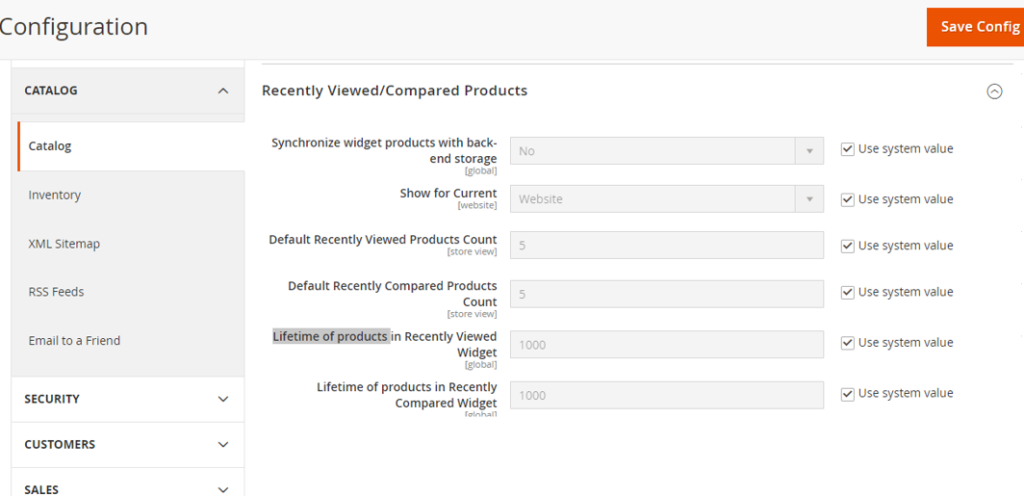
Step [1] – Go STORES > Configuration, redirects Configuration section.

Step [2] – Left panel under Catalog, choose Catalog

Step [3] – Go to Catalog & Expand the Recently Viewed/Compared Products section & follow below things

The following below steps need to follow to do Backup Settings in Magento 2.x / Adobe Commerce 2.x
Step [1] – Go To STORES > Configuration, redirects on configuration.
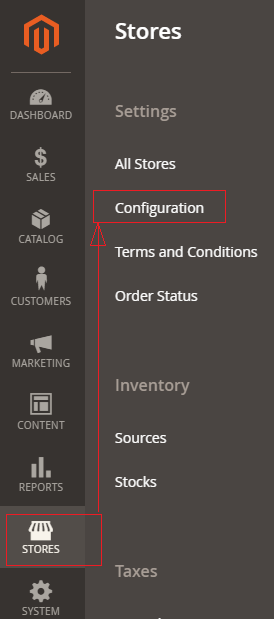
Step [2] – Left Panel Clicked on Advanced > System redirects on [Right Panel]
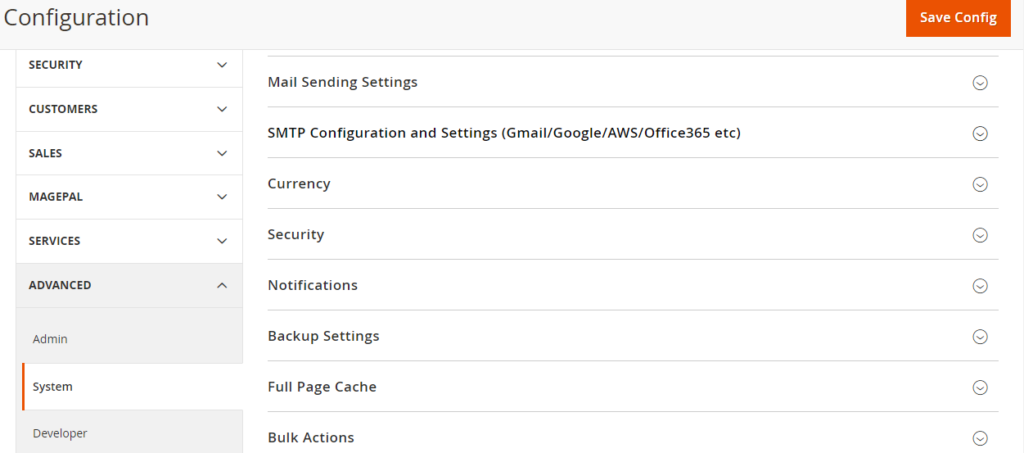
Step [3] – Click on Backup Settings of Right Panel
By Default Backup Settings Disable

Once Enable Backup Settings
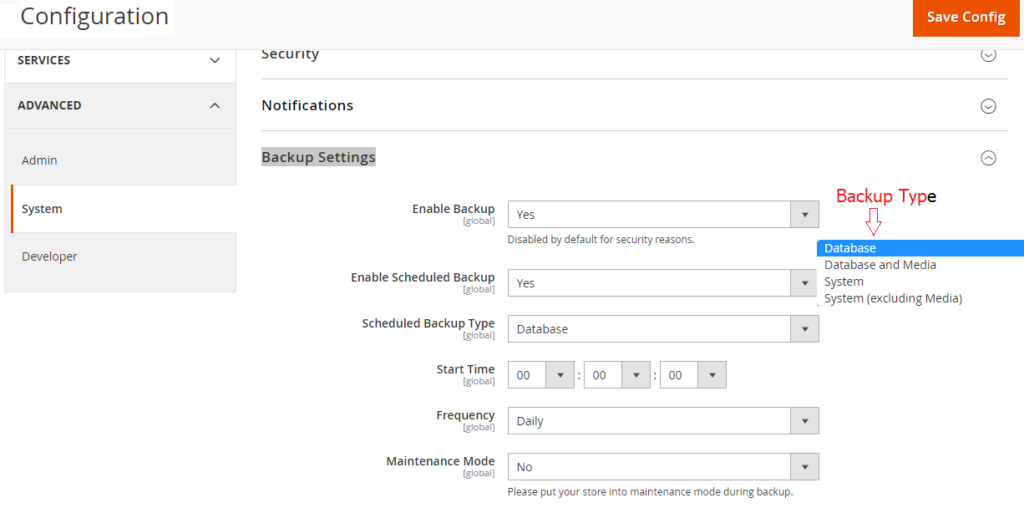

What is Security.txt File
The Security. txt file format is used to provide security researchers the information they can use to report their findings. Merchants can enter their contact information regarding security issue reporting from the Magento 2.x / Adobe Commerce Admin
Security. txt is set of Security standard to define the process for security researchers to disclose security vulnerabilities securely. security. txt files have been implemented by Google, Bling, Yahoo, Facebook, GitHub, the UK government, and many other organizations.
Step [1] – Go STORES > Configuration, redirects Configuration section.
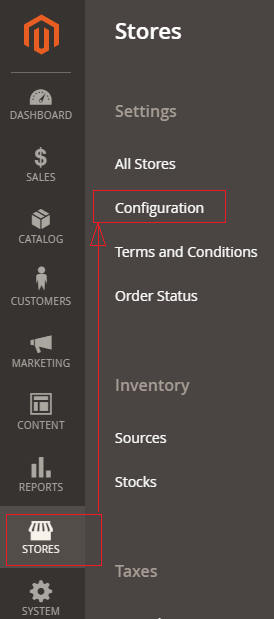
Step [2] – Left Side Panel Click on SECURITY > security.txt
By Default Security.txt disabled
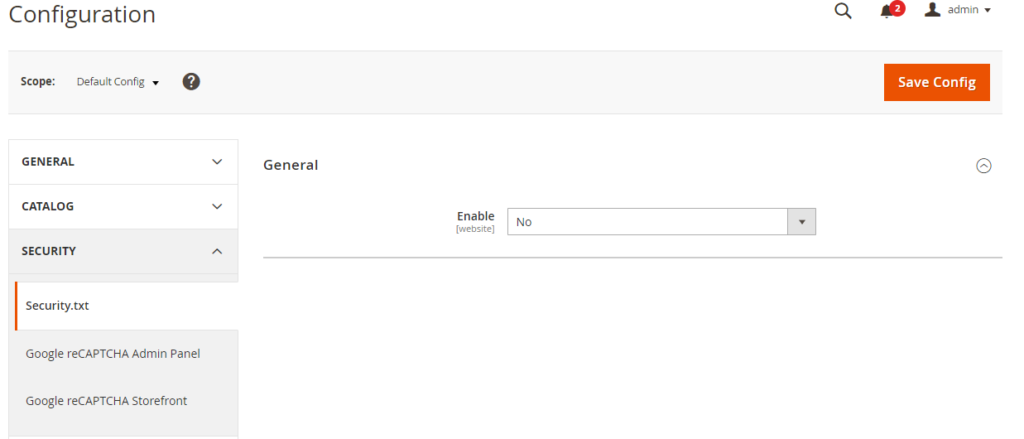

Step [3] – Once Click Enable (Select from drop down) below Tab display
“once enable, Creates the security.txt file based on information entered in the Contact information and Other information sections”

Contact Information:: Need to enter below information
Other Information:: Need to enter below information
If you want to create the signature file, then you have to use the command line:
gpg -u KEYID --output security.txt.sig --armor --detach-sig security.txtThe signature file has to be saved on the server in the .well-known folder.
Step [4] – Finally click on Save Button.
Step [5] – A valid security.txt file might look like the following:

Once authorize admin users are trying to login, due to some login credentials / Re Captcha issue , unable to admin login, after that multiple time unsuccessful login, authorize admin user has been locked.
The following below steps need to follow.
Step [1] – Go To Admin, System > Permissions > Locked Users
Step [2] –Redirects on below Locked Admin User Listing Page
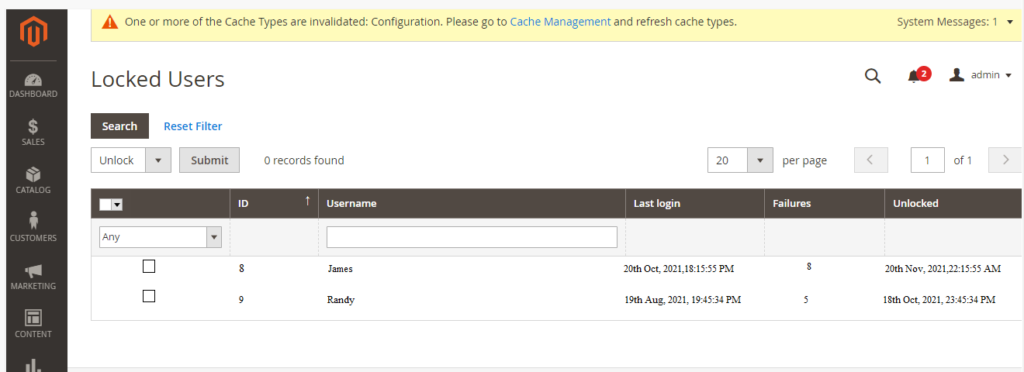
Step [3] – Select check box those admin users, you want to unlock & In the upper-left corner, set Unlock from the Actions dropdown box
Step [4] – Finally Click Submit to unlock the account.
Unlock Admin Users By Command
Step [1] – Run Below CLI command
$ bin/magento admin:user:unlock {username}Step [2] – Run Flush CLI Command
Step [3] – Finally user has been unlock.
Schedule Design Update specific duration period between Start Date & End Date, specify design /page /product / category / sore view theme must be display.
Schedule Design Update For Specific Page:: It is called on Page as Custom Design Update
Date From & To:: Select From & To Date
New Theme:: Select specific store view as per your Business Need
New Layout:: Select theme as per your Business Need

Schedule Design Update For Specific Product:: The following below things need to be set
Date From & To:: Select From & To Date
New Theme:: Select specific store view as per your Business Need
New Layout:: Select theme as per your Business Need

Schedule Design Update For Specific Page or Product follow same process
Schedule Design Update For Specific Category:: The following below thing need to be set
Date From & To:: Select From & To Date

Custom Design Update For Specific Theme:: The following below things need to be set
Store:: Select specific store view as per your Business Need
Custom Design:: Select theme as per your Business Need
Date From & To:: Select From & To Date
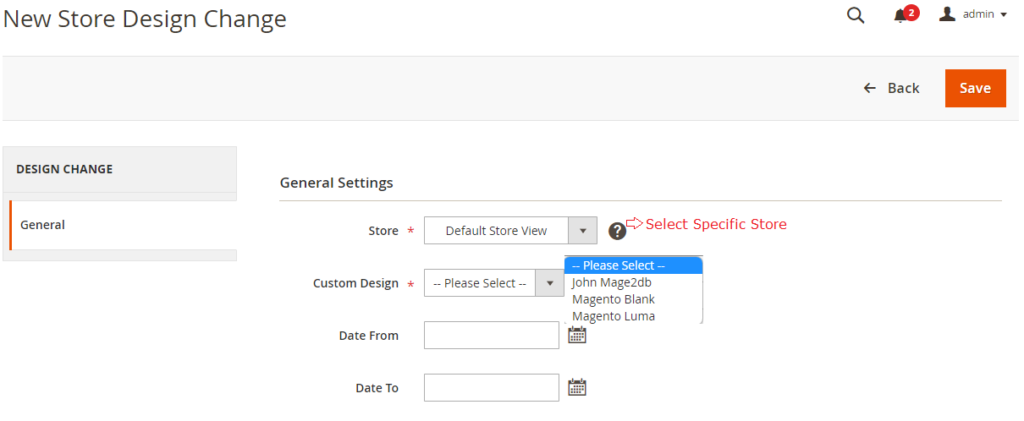
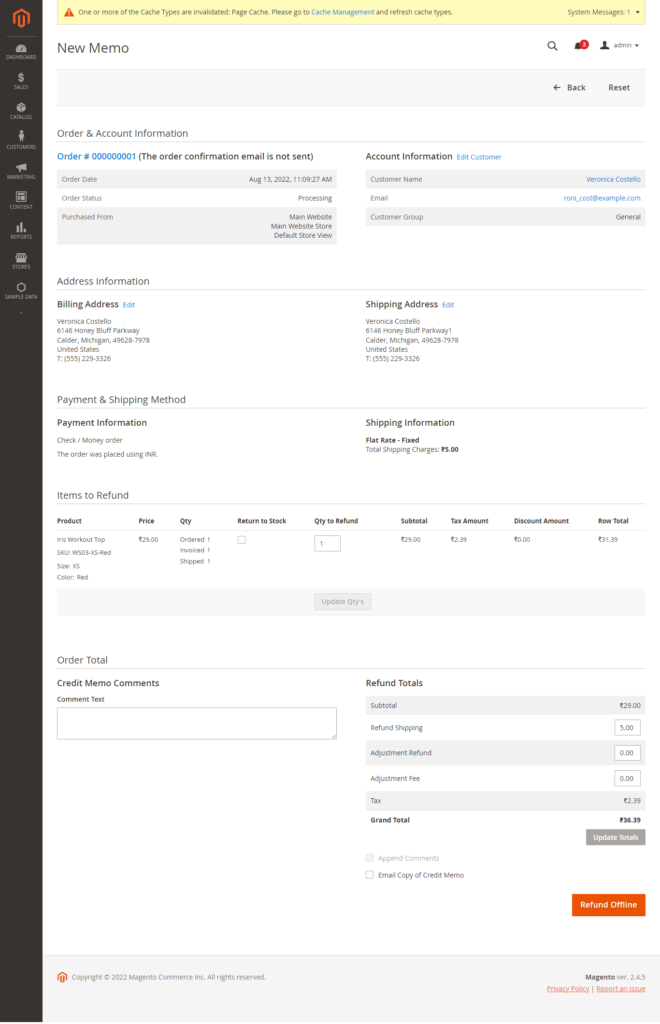
The Following below steps need to follow
Step [1] – Go To Left Side Content, set of (Element + Design + Dashboard + Media)

Step [2] – Briefly Explain
Elements = (Pages + Hierarchy + Blocks + Dynamic Block + Widgets + Templates)
Step [2.1] – Elements > Pages
“Create pages with set of text, images, blocks, variables, and widgets, these pages can be incorporated into the navigation (Top Navigation, Footer Navigation etc.) of your store as well as linked with other pages / catalog pages”
“Pages can be created by using Page Builder”
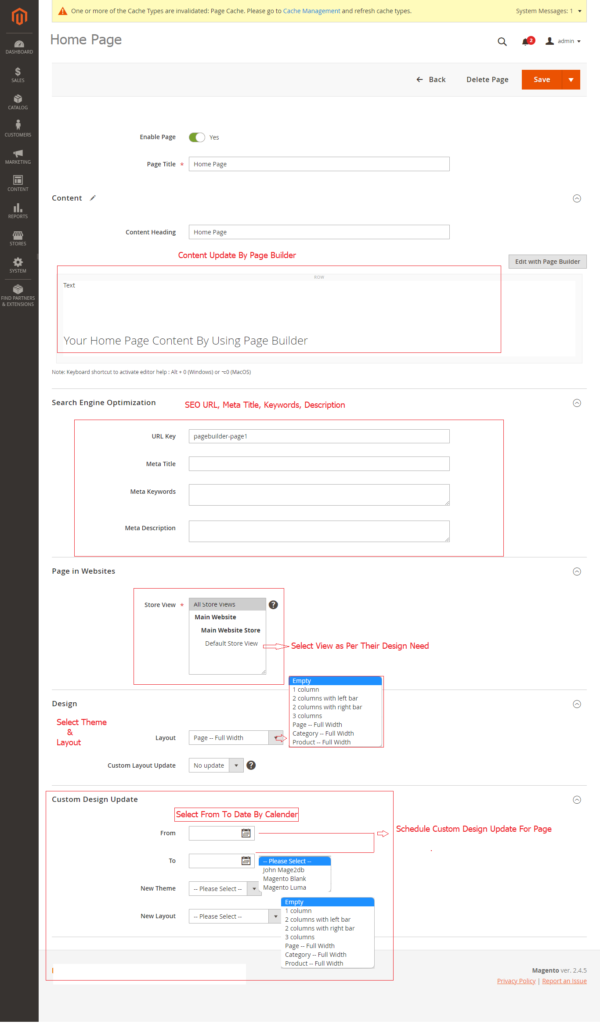


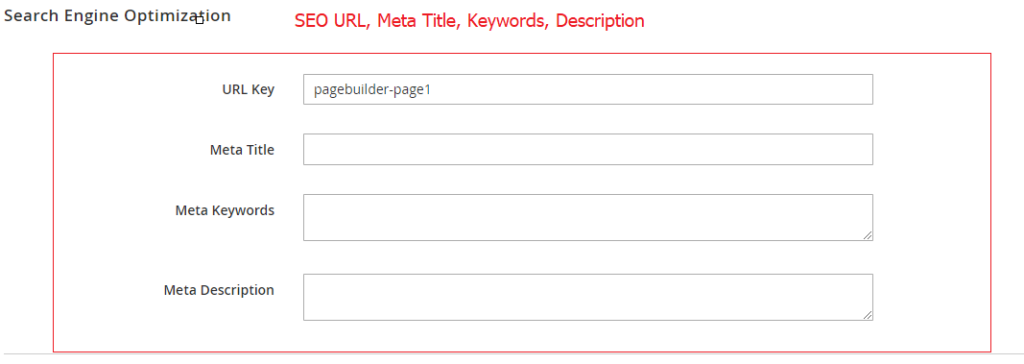


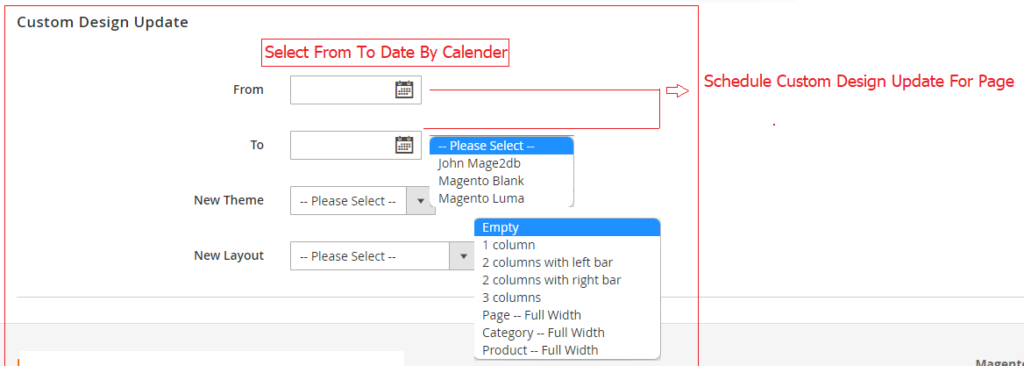
Once page created by using Page Builder, asking for which purpose want to save Page Template created for (Page, Block, Category, Product)

Step [2.2] – Elements > Hierarchy
“Hierarchy is set of content pages with pagination, navigation, and menus”
[2.2.1] Display Listing of Nodes

[2.2.2] – Once Click on Add New Node & enter Title & URL Key as below

[2.2.3] – Once click on Save Button, The node appears as a folder in the tree on the left of the page

[2.2.4] – How To Add Pages To The Node


Step [2.3] – Elements > Blocks
“Create block with set of text, images, and video and can be included to any part of the page layout / catalog page layout.“
“Blocks can be created by using Page Builder“

Step [2.4] – Elements > Dynamic Block –Only Support By Adobe Commerce
“Create block with set of dynamic & interaction content as by using logic with price rules (Cart Price Rules and Catalog Prices Rules) & customer segments.”
“Dynamic Blocks can be created by using Page Builder“
How To Create Dynamic Block:: The following below steps need to follow
Step [2.4.1] – Go to Content > Elements > Dynamic Blocks.
Display Listing of all Dynamic Blocks

Step [2.4.2] – Click on Button Add Dynamic Block

– Set Enable as Yes to activate the dynamic block
– Enter Dynamic Block Name
– Select Dynamic Block Type:: where you want to display dynamic block

– Select Customer Segmentation:: Which customer gender you are going to target Promotion

– If applicable, set Store View to a specific store view as per your Business need where the dynamic block is to appear
Step [2.4.3] – Enter Content by using Page Builder
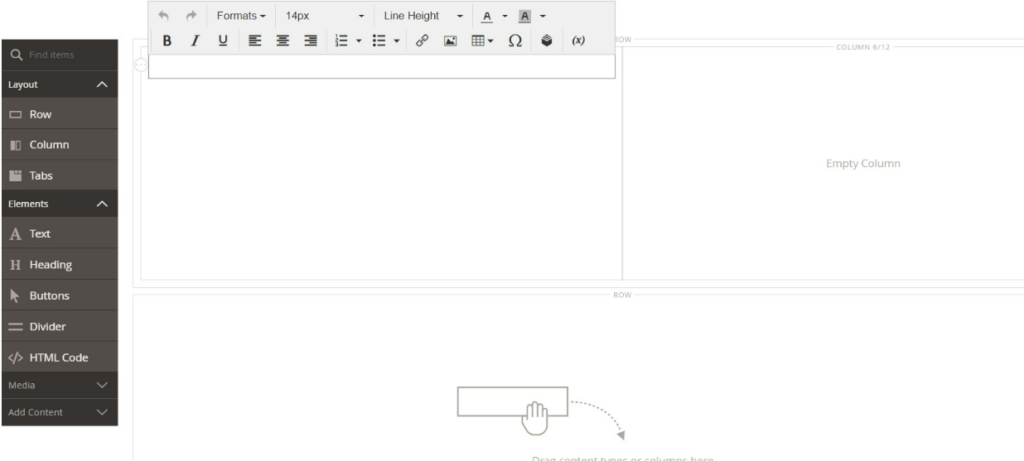
Step [2.4.4] – Integrate Cart Price Rules or Catalog Price Rules as per your business need
You should select the checkbox of each rule you want to add, no matter what rule option is selected. Don’t forget to click Add Selected and save the block when finished.

Select checkbox below Cart Price Rules, that you planning to apply,
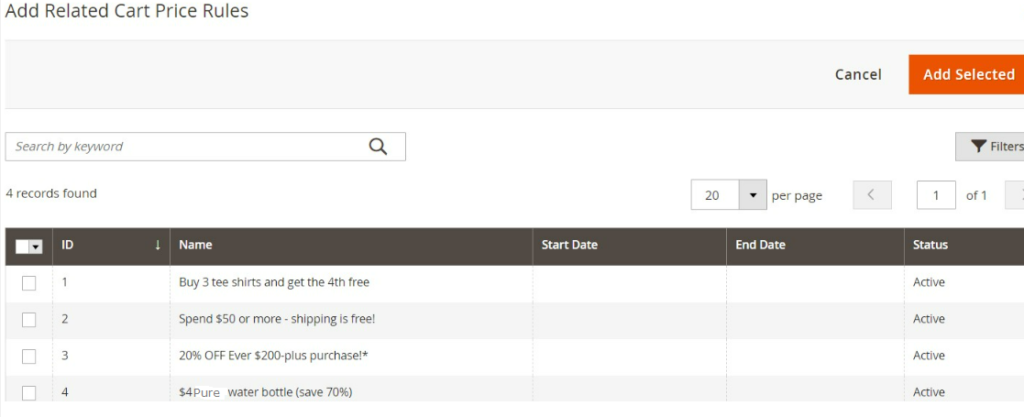
Same process need to apply for Catalog Price Rules
Step [2.4.5] – Finally click on Save Button
Step [2.4.6] – How To apply Dynamic Blocks on Pages.
Go to Content > Elements > Pages , select dynamic block that is recently created by using Add Dynamic Block content type
Step [2.5] – Elements > Widgets
” Widget is a snippet of code or dynamic data that allows you to display dynamic content on your store frontend.“
“Widget is set of following below Dynamic data, users can be used as per their need. “
CMS Page Link
CMS Static Block
Catalog Category Link
Catalog New Products List
Catalog Product Link
Catalog Products List
Orders and Returns
Recently Compared Products
Recently Viewed Products
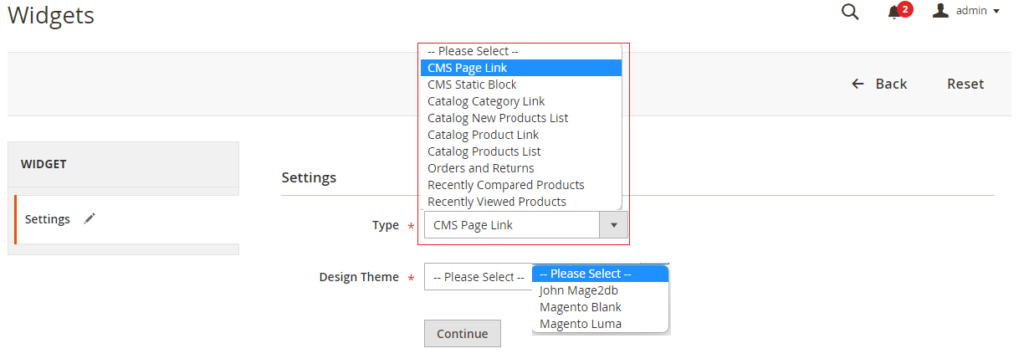
Step [2.6] – Elements > Templates:: Display listing of all templates those are created by Page Builder for Pages, Products, Categories, Blocks etc.

Step [3] – Content Staging — Only Support By Adobe Commerce
Content Staging provides facility for Admin User to easily Create, Preview & Schedule a wide range of content updates directly from the Admin of your store.
Schedule Update for following below thing
Products
Categories
Catalog Price Rules
Cart Price Rules
CMS Pages
CMS Blocks
Widgets

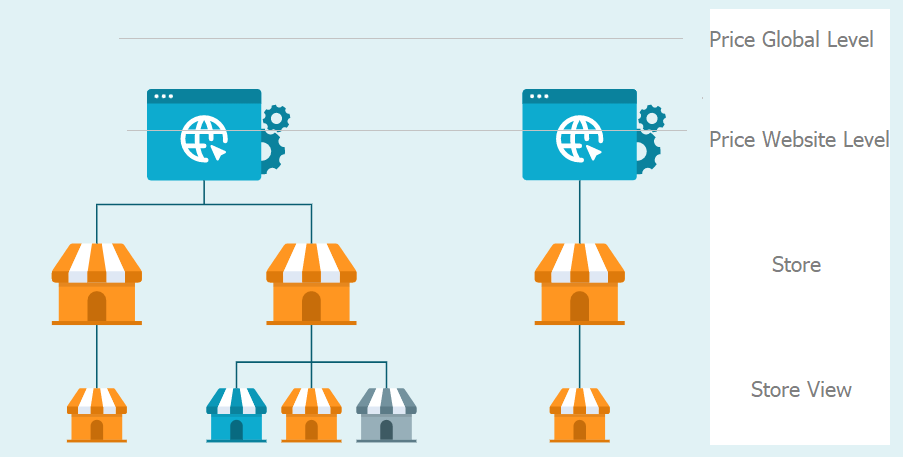
Product Price can be set either by Global or Website Scope Level in Magento 2.x / Adobe Commerce 2.x,
If applied to the global level, the same price is used throughout the store hierarchy level.
If applied to the website level, the same product can be available at different prices from stores that are associated with different websites.
By Default Product Price as Global Level
Product Price can not be set either by Store Level in Magento 2.x / Adobe Commerce 2.x
How To Configure Product Price Scope Either Global or Website Level
The following below steps need to follow to Configure Product Price Scope Global or Website Level
Step [1] – Go To STORES > Configuration, redirects on configuration.
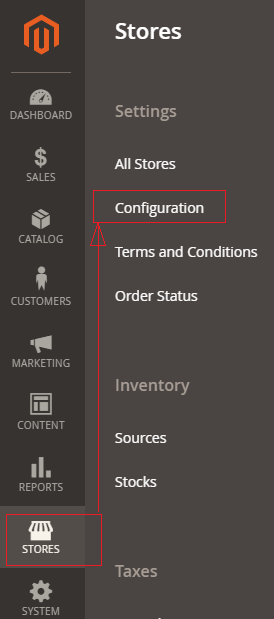
Step [2] – In the left panel, expand Catalog and choose Catalog underneath.
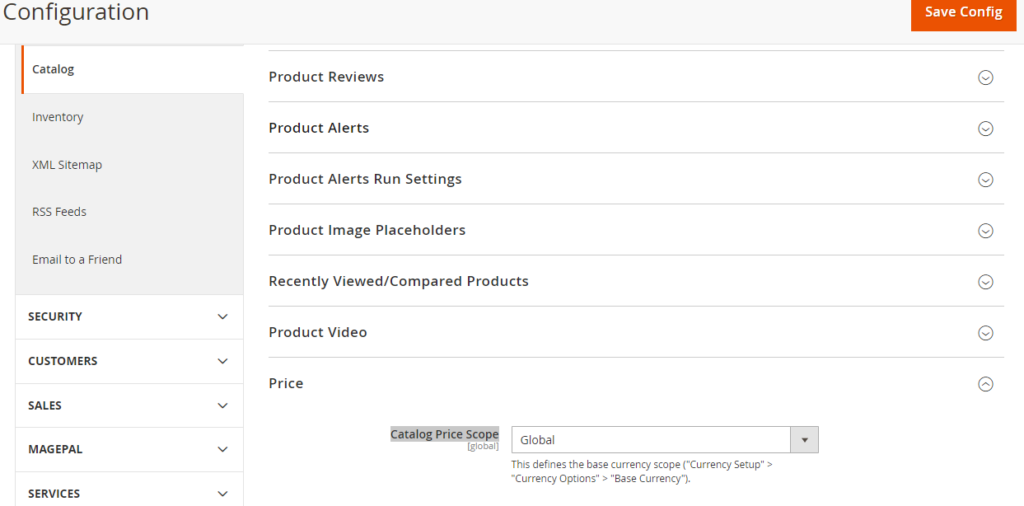
Step [3] – Once Scroll down to the Catalog Price Scope following below two values:
Global [By Default Selected]
Website
Step [4] – The scope setting that you choose appears below price fields in your catalog.

Step [5] – When complete, click Save Config.
Magento 2.x or Adobe Commerce Sales Reports having details Sales Reports( filtered by time interval, date, and status etc.) for following below.
Sales Orders
Sales Tax
Sales Invoiced
Sales Shipping
Sales Refunds
Sales Coupons
Sales Paypal Settlement
The following below steps need to follow to generate each above Sales Reports
Step [1] – In Admin Panel, Go To Reports > Sales
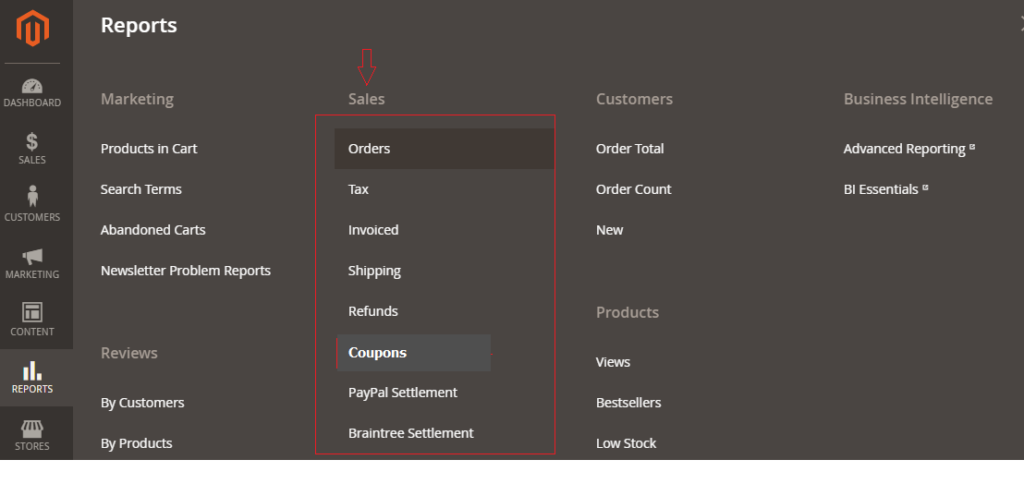
Admin can generate a report for a whole website or specific store, within a time interval or a date. To filter a sales report, set the following options:
| Option | Description |
| Date Used | Indicates Sets the data to be used for the report. |
| Period | Indicates The period for which the data is used: Day/Month/Year. |
| From/To | Indicates Used to define search data by start and end date. |
| Order Status | Indicates the order status |
| Empty Rows | Indicates whether to add blank rows to the report. |
Step [2] – To Generate Sales Orders Report
It is filtered by time interval, date, and status. The report includes the number of orders placed and canceled, with totals for sales, amounts invoiced, refunded, tax collected, shipping charged, and discounts.
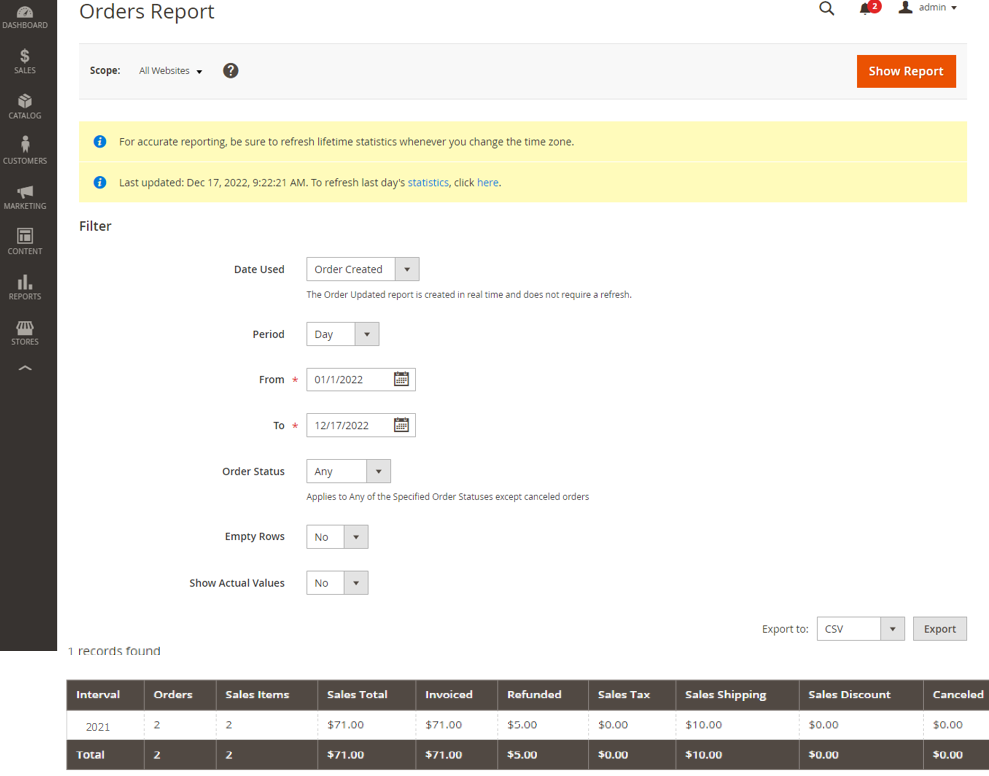
Step [3] – To Generate Sales Tax Report
It is being filtered by time interval, date, and status. The report includes the tax rule applied, tax rate, number of orders, and amount of tax charged.
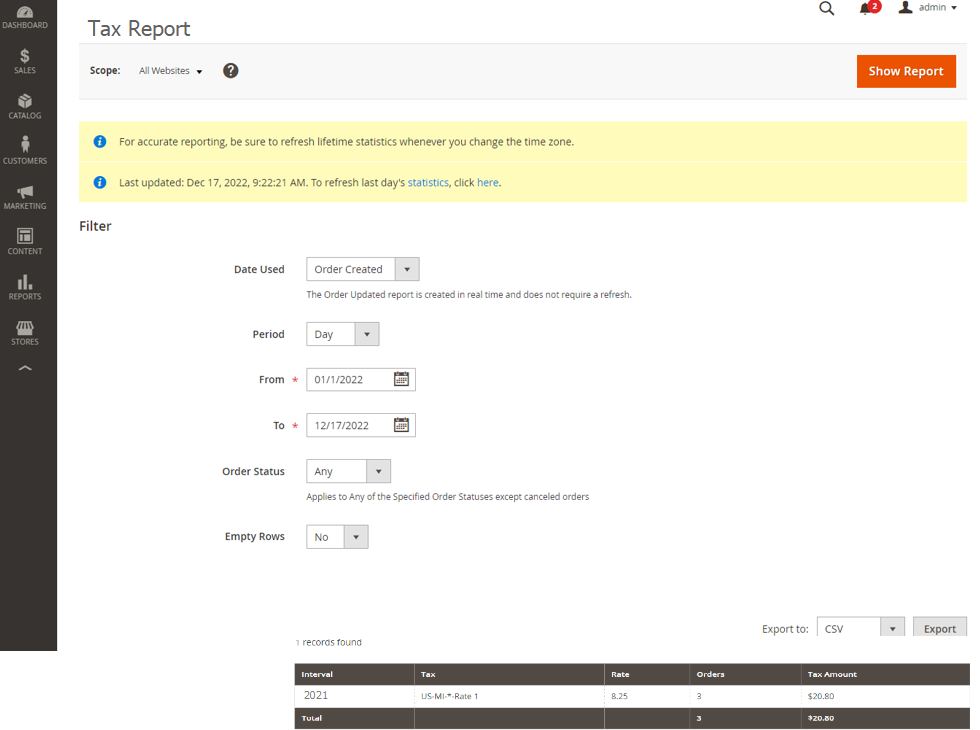
Step [4] – To Generate Invoiced Report
It is being filtered by time interval, date, and status. The report includes the number of orders and invoices during the time period, with amounts invoiced, paid, and unpaid.
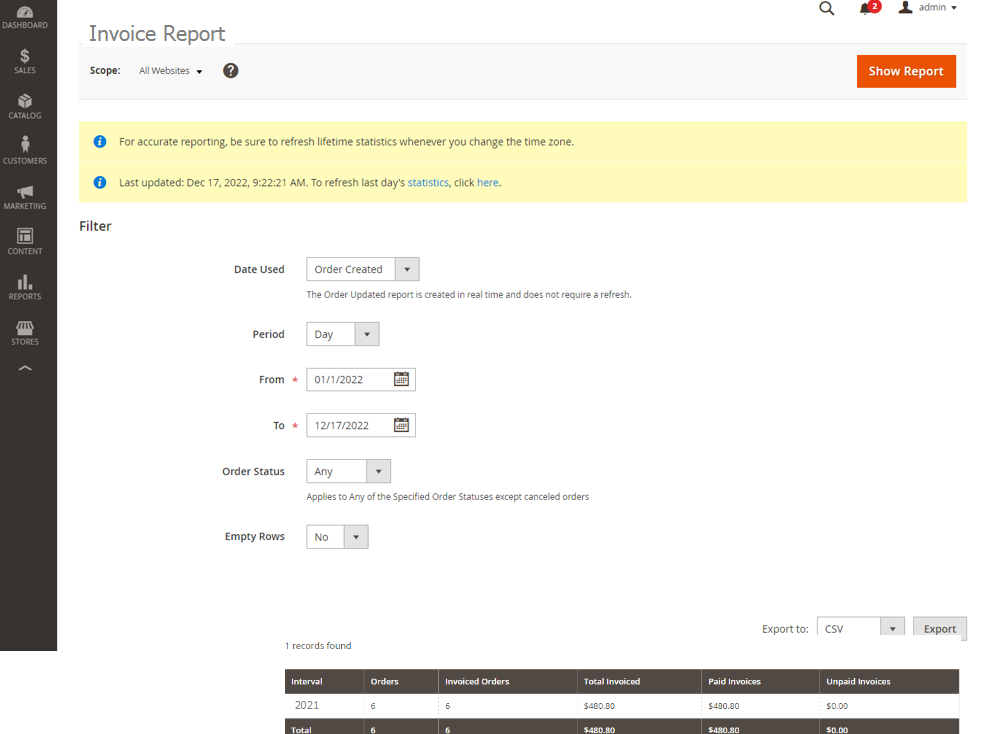
Step [5] – To Generate Sales Shipping Report
It is being filtered by time interval, date, and status. The report includes the number of orders for carrier or shipping method used, with amounts for total sales and total shipping.
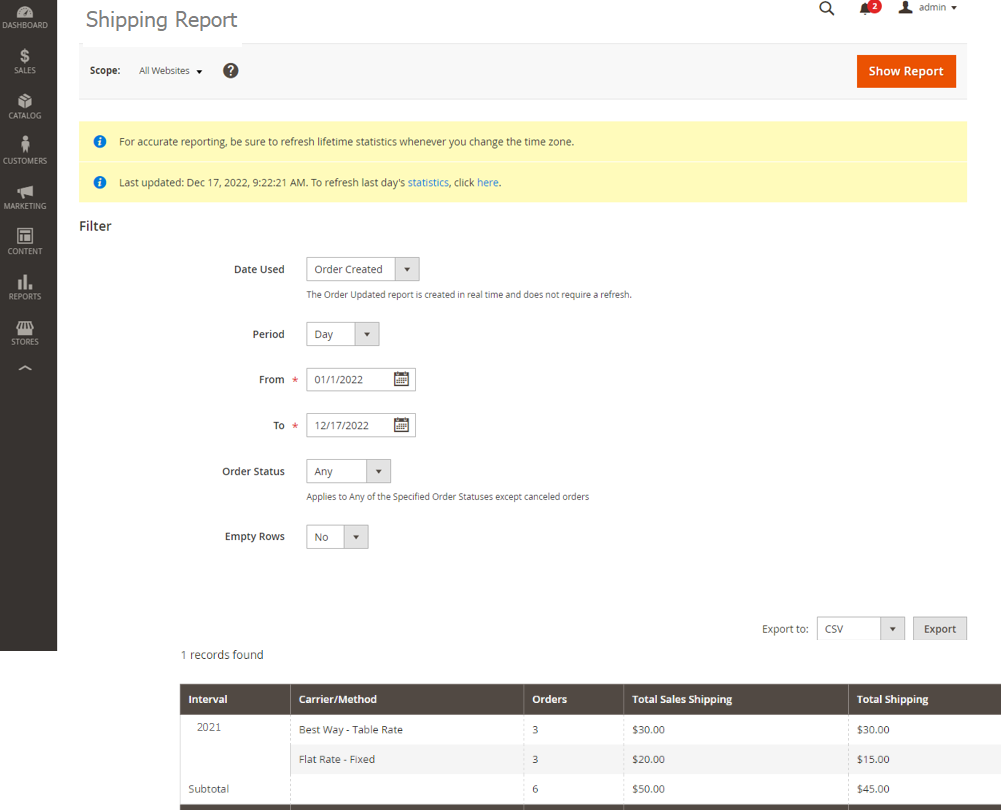
Step [6] – To Generate Sales Refunds Report
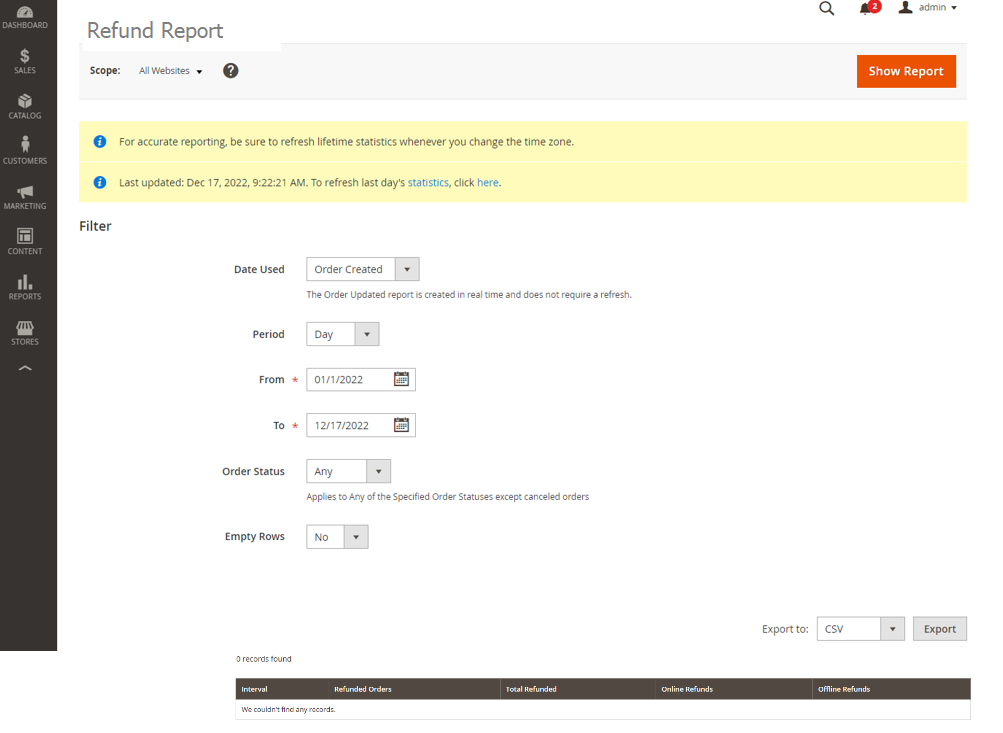
It is being filtered by time interval, date, and status. The report includes the number of refunded orders, and total amount refunded online and offline.
Step [7] – To Generate Sales Coupons Report
It is being filtered by time interval, date, and status. The report includes each coupon code used during the specified time interval, related price rule, and number of times used, with totals and subtotals for sales and discounts.
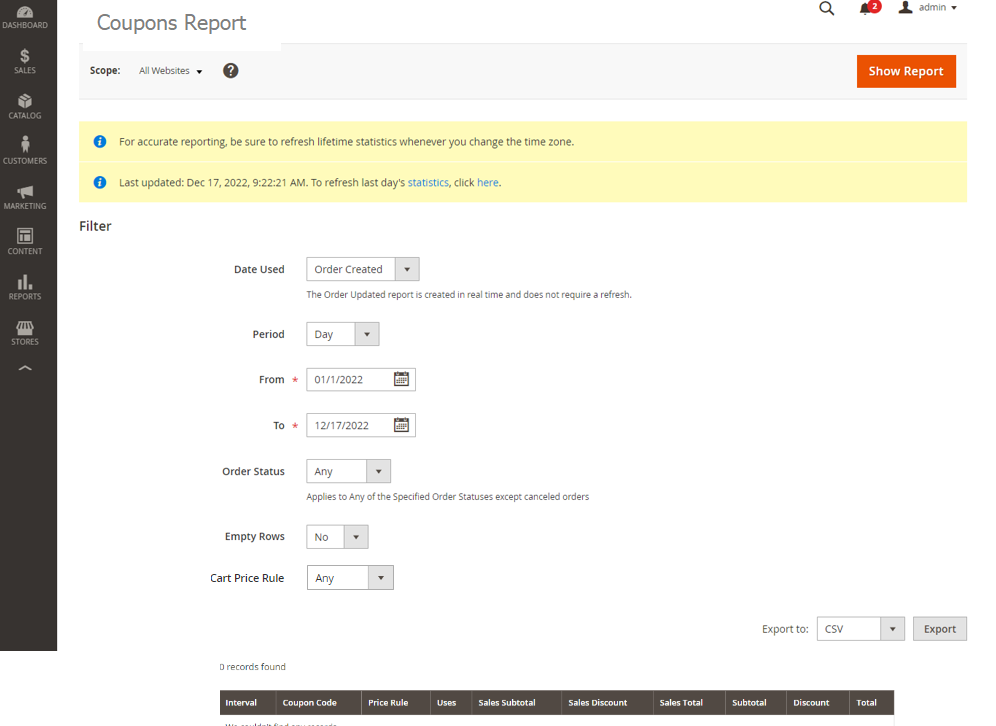
Step [7] – To Generate Sales Paypal Settlement Report
It is being filtered by date, merchant account, transaction ID, invoice ID, or PayPal reference ID. The report includes the type of event, such as a debit card transaction, the start and finish dates, gross amount, and related fees.

The following below steps need to find out Coupons Reports
Step [1] – In Admin Panel, Go To Reports > Sales > Coupons

Step [2] – If you store have multiple store views, set Store View in the upper-left corner to establish the scope of the report.
Step [3] – To refresh the sales statistics for the day, click the Last Updated message at the top of the workspace. Then, click to select the Coupons checkbox and click Refresh.
Coupons report – refresh statistics
Refresh Statistics
Step [4] – To filter the data, do the following:

Step [4.1] – Coupons Reports Filter as below
Step [4.2] – Set Date Used to one of the following:
[a] Order Created
[b] Order Updated
The Order Updated report is created in real-time and does not require a refresh.
Step [4.3] – To define the period of time covered by the report, set Period to one of the following:
Day
Month
Year
Step [4.4] – To define the date range of the report, enter the From and To dates in M/D/YY format.
Step [4.5] – To print a report for a specific order status, set Order Status to Specified and choose the order status from the list.
Step [4.6] – To omit rows without data from the report, set Empty Rows to No.
Step [4.7] – To define coupon activity included in the report, do one of the following:
[a] To include all coupon activity from all price rules, set Cart Price Rule to Any.
[b] To include only activity related to a specific price rule, set Cart Price Rule to Specified and select the cart price rule in the list.
Step [5] – Finally click on Report Button
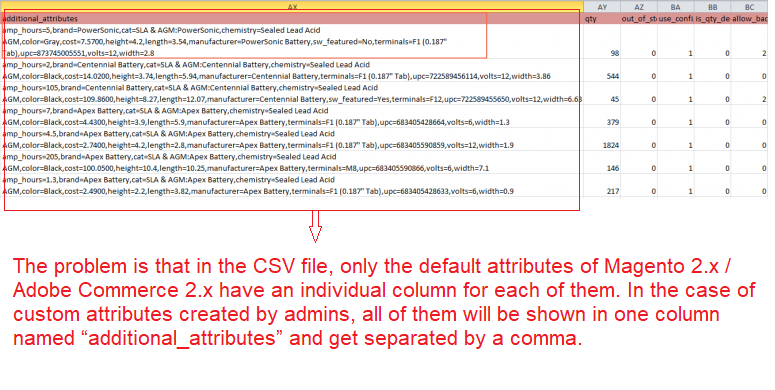
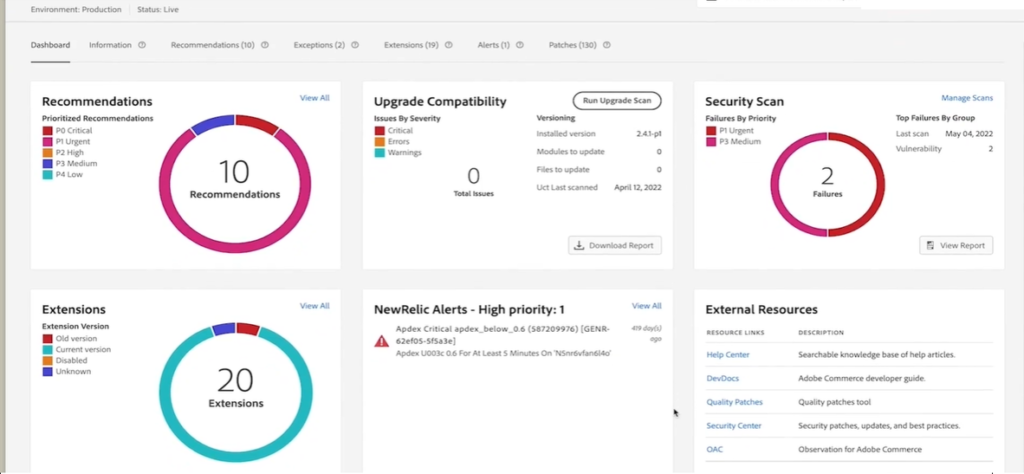
Adobe Commerce supports Site-Wide Analysis Tool (SWAT) & It is 24/7 Real-Time Performance to provides Reports & Recommendation to ensure performance, security, availability & operability of running site/store & monitoring provides multiple reports & advice to identify potential issues and better visibility into site health, safely, safety & application configurations. It helps reduce resolution time & improve site speed , stability and performance.
“Adobe Commerce supports Site-Wide Analysis Tool (SWAT) 24*7 monitoring tool to check Store / Site Health”
Site-Wide Analysis Tool (SWAT) follow below Reports & Recommendation
The Following below admin setting required to enable Multiple Shipping Address.
Step [1] – Go Reports > System Insights, redirects (SWAT) section below.
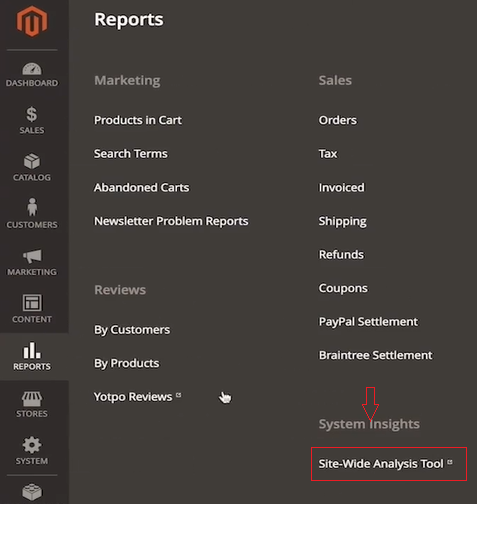

Step [1] – List of Recommendation
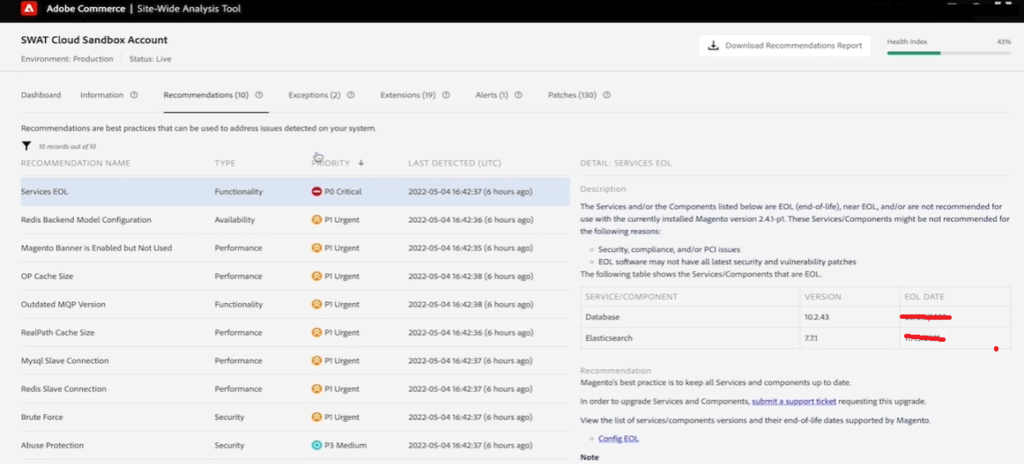
Step [2] – List of Exceptions
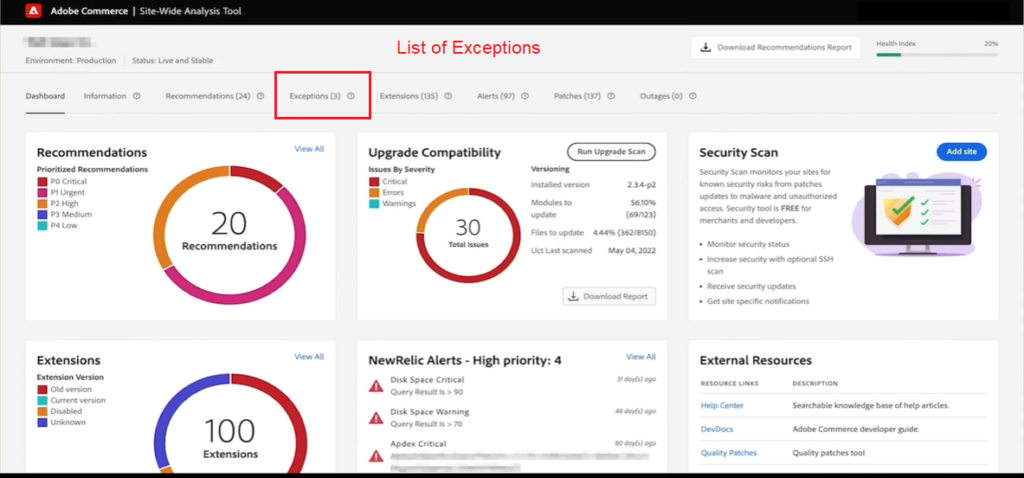
Step [3] – List of Extensions Analysis
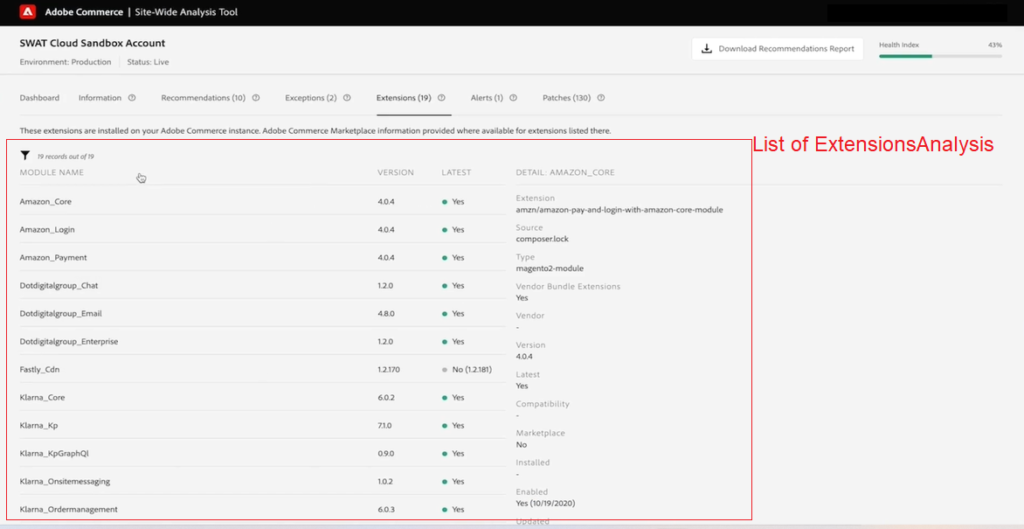
Step [4] – List of Security Patches Analysis
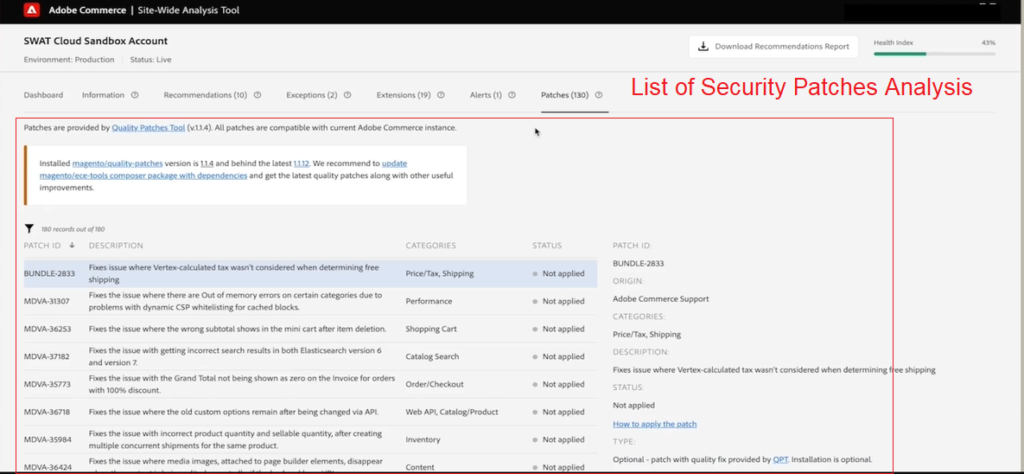
Step [5] – List of Security Installed Extension Analysis

Step [6] – List of Upgrade Compatibility Analysis
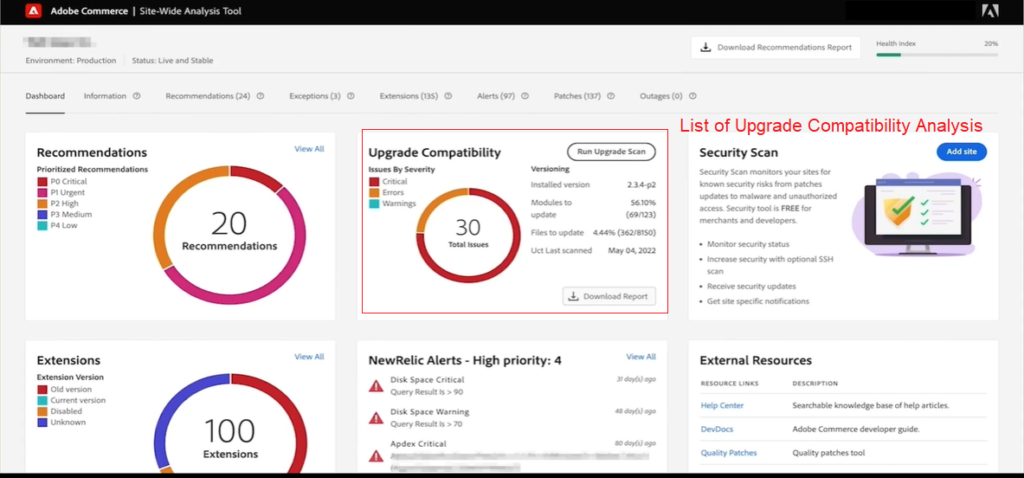
Step [7] – List of Security Scan Analysis
